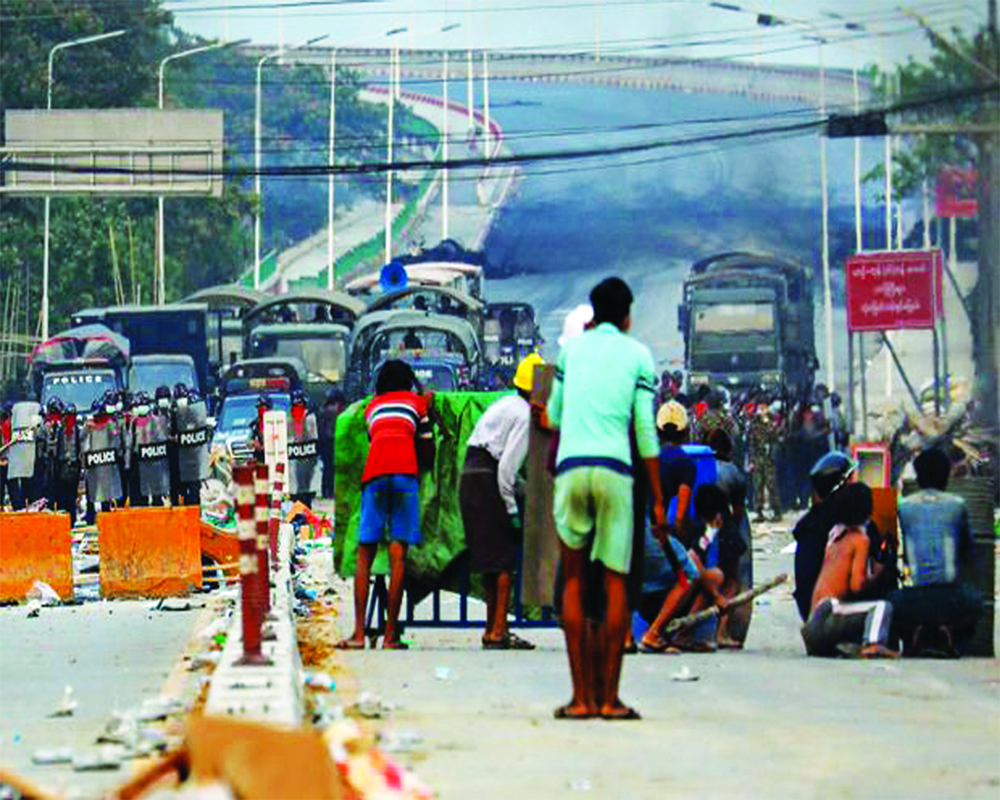The situation in our strife-torn neighbourhood is turning worse, with the military trying every trick in the book to cling to power
As a result of the Myanmar military’s (Tatmadaw’s) takeover of the political power and arrest of the elected representatives on February 1 this year, the people of Myanmar came out in thousands to demonstrate against the coup. The military claims that it took over the power under the State of Emergency clause of the 2008 Constitution (written by the military itself) because of an alleged electoral fraud. However, the Election Commission had declared the November 2020 elections as free and largely fair.
The court of public opinion pronounced its verdict through spontaneous demonstrations that have since early February claimed nearly 500 lives. People’s anger reveals that the military’s allegations are a mere pretext to take over the power to protect the illegitimate businesses of their family members, threatened by the Aung San Suu Kyi-led National League of Democracy’s (NLD) overwhelming success in the polls.
Though there were no cases of public unrest or breakdown in law and order to justify the Emergency and the military’s takeover, the military chief, Senior Gen Min Aung Hlaing, arrested the President and replaced him with his puppet Vice-President, who promptly declared Emergency for the military to take power. The elected representatives were prevented from taking the oath of office on February 1. Clearly, the coup by Senior Gen Min Aung Hlaing and other Generals was not against Suu Kyi but against the people of Myanmar.
The coup’s consequences have since played out via public protests and random shootings by troops who have been given a free hand to terrorise and coerce the population to surrender their basic rights. The seeds of the Tatmadaw gaining political clout in Myanmar stem from the first military coup in 1962. Following socio-political changes over the years, the Generals chose to allow elections under the 2008 Constitution. It had nearly 35 provisions that allowed the military to hold primacy in political decision-making at the Central and provincial Government levels.
As large swathes of Myanmar’s territory were inhabited by around 18 major ethnic communities, with approximately 35 per cent of the population, the majority Barmar population inhabited the central fertile basins of the Irrawaddy and Salween rivers. The minorities since the 1960s raised their own Ethnic Armed Organisations (EAOs) for self-protection, which gave the Tatmadaw the rationale to hold the centre stage of national integrity. The 2008 Constitution gave it political powers by holding 25 per cent of the seats in both national and regional/State Parliaments by the nominees of the Army chief, Senior Gen Min Aung Hlaing. In time, the Tatmadaw came to represent private business interests of the Generals and Colonels, not of the Myanmar people.
Moving to the events that unfolded rather quickly after the coup, the elected legislators on the military’s target fled the country. A group of legislators went underground and organised itself as the CRPH, or the Committee Representing Pyidaungsi Hluttaw (Parliament). The military, to control the civilian protests, has generally followed the strategy of closing down mobile phone communications and the internet, declaration of Emergency and martial law to arrest protesters without trial, and shock and awe by random killings of protesters. Of late, a change has been noticed in its strategy. It has started bombings ethnic villages to provoke reactions from the main EAOs. This would aim to justify the military’s intervention as the protector of the majority Barmars.
What are the options for civil society in Myanmar, with its elected leaders and the EAOs being attacked by the Tatmadaw? Its main argument to retain military control is that the EAOs want to splinter Myanmar into ethno-territorial identities.
Interviewed by the Al Jazeera on March 27, NLD legislator Sarsa (now in hiding) sought global help in providing alternative strategies to put Myanmar back on the path of lasting democratic peace and stability. UN Special Rapporteur Tom Andrews, however, was unable to offer any alternative solution. A similar expression of helplessness and outrage has been made by the UN Secretary, the US President, the EU and the Asean countries.
The international community needs to treat the ongoing violence in Myanmar not as a conflict resolution issue fit for negotiations, but as a problem of the flawed Constitution. This flaw is a deliberate design by the Myanmar Generals to permanently snatch their people’s sovereign rights at the point of their weapons.
So, what should and could India do as a neighbour, as a democracy and as a member of the UN Security Council? Even if the Government has taken a politique approach, the people of India and the free press has to step up to restore democratic peace and humanitarian relief to the troubled refugees fleeing Myanmar.
(The writer is a military veteran, who is a former Senior Fellow at the Institute for Defence Studies & Analyses, New Delhi, and Ford Fellow at the School of Public Affairs, University of Maryland. The views expressed are personal.)


























